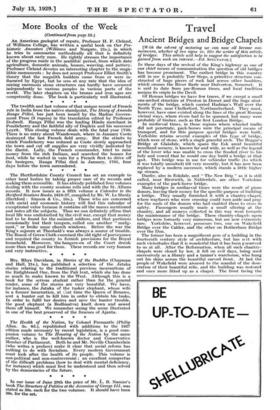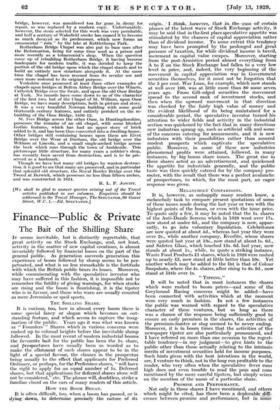Travel
Ancient Bridges and Bridge Chapels
ith the advent of motoring we can now all become con- noisseurs, whether of inn signs or, like the writer of this article, of bridges. This article will help to suggest the satisfaction to be gained from such an interest.—Ed. SPECTATOR.)
IN these days of the revival of the King's highway as one of our chief means of communication the question of old bridges has become prominent. The earliest bridge in this country still in use is probably Torr Steps, a primitive structure con- structed of huge pieces of rock laid across other boulders, which crosses the River Barle near Dulverton, Somerset. It is said to date from pre-Roman times, and local tradition assigns its origin to the Devil.
Of Roman bridges we have few traces, if we except a small one-arched structure at Preston in Dorset and the huge abut- ments of the bridge, which carried Hadrian's Wall over the North Tyne, near Chollerford, Northumberland. They must, however, have once existed along the lines of the great Roman vicinal ways, where rivers had to be spanned, but many were probably of timber, such as the first London Bridge. In mediaeval times, in those regions where wheeled traffic did not penetrate, pack-horses were the principal means of transport, and for this purpose special bridges were built. Yorkshire retains several examples of this type of bridge, which were of stone, with a single graceful arch. The Beggar's Bridge at Glaisdale, which spans the Esk amid beautiful woodland scenery, is known far and wide, as well as the legend of the lover who was unable to cross the Hooded river to his lady and vowed that he would one day build a bridge at that spot. This bridge was in use for vehicular traffic (to which it was totally unsuited) till very recently, but it has now been replaced by a modern successor, which stands a little higher up stream.
Danby, also in Eskdale, and " The New Brig " as it is still called, near Birstwith, in Nidderdale, are other Yorkshire examples of the pack-horse bridge.
Many bridges m mediaeval times were the result of pious donors, leaving their money for the specific purpose of building a bridge. They usually furnished it with a chantry-chapel, where wayfarers who were crossing could turn aside and pray for the souls of the donors who had enabled them to cross in safety. Passengers usually made a small offering at the chantry, and all moneys collected in this way went towards the maintenance of the bridge. These chantry-chapels upon bridges were formerly very numerous, but are now extremely rare. Yorkshire, however, possesses two, one on Wakefield Bridge over the Calder, and the other on Rotherham Bridge over the Don.
The former has been a magnificent gem of a building in the fourteenth century style of architecture, but has ix et with such vicissitudes that it is wonderful that it has been p reserved to us at all. After the Reformation, when all such chantry- chapels were closed by law, it fell on evil days, being used successively as a library and a tanner's warehouse, who hung out his skins across the beautiful carved front. At last the people of Wakefield were aroused to the scandal of the dese- cration of their beautiful relic, and the building was restored and once more fitted up as a chapel. The front facing the
bridge, however, was considered too far gope in_clecay_ for repair, so was replaced by a modern copy. Unfortunately, however, the stone selected for this work was very perishable, and half a century of Wakefield smoke has caused it to become as much decayed as its predecessor, which now forms an ornamental " ruin " by the lake at Kettlethorpe Park.
Rotherham Bridge Chapel was also put to base uses after the Reformation, being for some time used as a prison and more recently as a tobacconist's shop. When the question came up of rebuilding Rotherham Bridge, it having become inadequate for modern traffic, it was decided to keep the portion of the old bridge upon which the chapel stands and to build an entirely new structure alongside it. At the same time the chapel has been rescued from its secular use and once more restored to its original purpose. Yorkshire once possessed at ]east three other examples of chapels upon bridges at Bolton Abbey Bridge over the Wharfe, Catterick Bridge over the Swale, and upon the old Ouse Bridge at York. No records have come down to us of the character of the first two, but of the Chapel of St. William, upon Ouse Bridge, we have many descriptions, both in picture and story. It was a very beautiful Norman building with some good thirteenth century features, and entirely perished on the re- building of the Ouse Bridge, 1810-12. St. Ives Bridge across the other Ouse, in Huntingdonshire, possesses the remains of an old chapel, with some blocked Gothic features, which has had an upper story of brick added to it, and has been thus converted into a dwelling-house. Other bridges still containing houses upon them are Elvet Bridge over the Wear at Durham, the old bridge over the Witham at Lincoln, and a small single-arched bridge across the beck which runs through the town of Ambleside. This picturesque little structure, for many years a cobbler's shop, has recently been saved from destruction, and is to be pre- served as a landmark.
Though we have lost many old bridges by wanton destruc- tion, it is good to see that many are preserved, and in particular that splendid old structure, the Royal Border Bridge over the Tweed at Berwick, which possesses no less than fifteen arches, and was constructed in 1624.
R L. P. Jowrrr.
[We shall be glad to answer queries arising out of the Travel articles published in our columns. Enquiries should be addressed to the Travel Manager, The SPECTATOR, 99 Gower Street, W.C. 1.—Ed. SPECTATOR.]

































 Previous page
Previous page